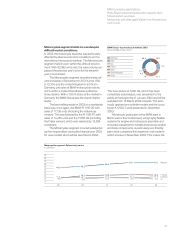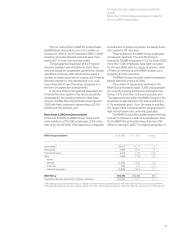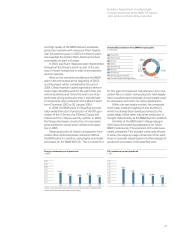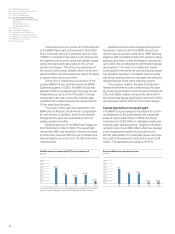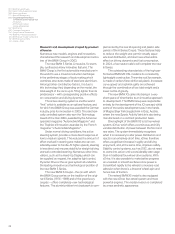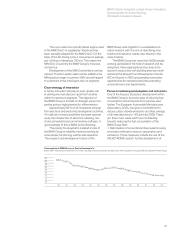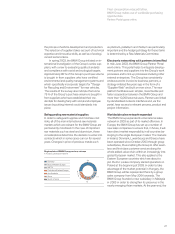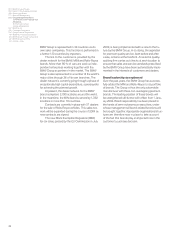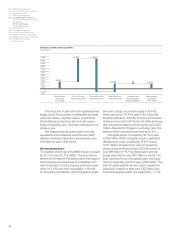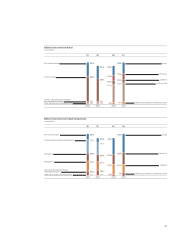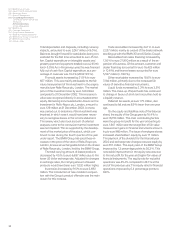BMW 2003 Annual Report Download - page 27
Download and view the complete annual report
Please find page 27 of the 2003 BMW annual report below. You can navigate through the pages in the report by either clicking on the pages listed below, or by using the keyword search tool below to find specific information within the annual report.001 BMW Group in figures
004 Report of the Supervisory Board
008 Supervisory Board
011 Board of Management
012 Group Management Report
12 A Review of the Financial Year
29 Outlook
30 Financial Analysis
44 Risk Management
047 BMW Stock
050 Corporate Governance
054 Group Financial Statements
118 BMW AG Principal Subsidiaries
120 BMW Group10-year Comparison
122 BMW Group Locations
124 Glossary, Index
26
engine technology and new concepts for construc-
tion with lightweight materials.
2. The introduction of new low-consumption models
and model series in the lower segments; this in-
cludes the MINI brand and the new BMW 1 Series.
3. The hydrogen engine, which is CO2emission free,
is considered to be the long-term option for engine
technology.
Hydrogen as the energy source of the future
With decades of experience now behind it in this
field, the BMW Group’s hydrogen engine is a fully
developed technology which is more efficient than
that used for conventional engines. By comparison
to the fuel cell, the hydrogen engine immediately
impresses with its simple, familiar handling, lighter
weight, lower price and better performance. In these
early stages of the move into the hydrogen era, the
engine has the advantage that it can be powered by
hydrogen or petrol, depending on availability. The
BMW Group is pushing on with the series develop-
ment of the hydrogen engine and, within the life-
cycle of the current BMW 7 Series, a hydrogen-
powered version will be available to customers.
BMW’s CleanEnergy concept is committed to a
future based on hydrogen since it can be obtained
on a long-term basis from regenerative sources
of energy.
Design for Recycling
As part of the “Design for Recycling” project, re-
cycling experts are working closely with engineers
from the BMW Group’s Research and Development
Centre. Right at the product development stage,
experts give detailed recommendations for the opti-
mal design of components from a recycling point
of view, so that end-of-life recycling and recovery
of all of BMW Group’s models is economical and
environmentally compatible. Knowledge gained on
vehicle recycling is made available to all recycling
and recovery organisations via an international data-
base maintained by a number of car manufacturers.
The objective is to create circular processes which
are both ecological and economical.The
BMW
Group
is already making use of high-quality recyclable
materials in its products. Plastic components used
in the new BMW 5 Series, for example, have been
selected with a view to their being recycled at a later
date.
International purchasing network expanded
In 2003, the BMW Group expanded its international
network of purchasing centres. Amongst various
measures taken, an office was opened in Singapore
with the objective of increasing regional purchasing
potential in the AFTA region. In conjunction with
the start of production of the BMW 3 Series by the
joint venture company set up with Brilliance China
Automotive Holdings, in Shenyang, the BMW Group
has successfully been able to add local suppliers
to the supplier network. In preparation for the EU
enlargement in 2004, the Group has evaluated the
impact on the local supply markets in Eastern Euro-
pean countries which will be joining the EU and in-
corporated the results into the long-term purchasing
strategy.
Purchase volume in NAFTA region increased
Almost one half of the BMW Group’s purchase vol-
ume is now bought in from outside Germany. This
underlines the Group’s claim that it is systematically
using the global purchasing markets to supply its
production network. By making further use of the
potential of the purchasing markets in the NAFTA
region, the BMW Group was also able in 2003 to
offset its US dollar receipts from sales.The renewed
increase in production volumes of the MINI resulted
in above-average growth of the Group’s
purchase
volume from South America, where engines
for the
MINI are purchased.
Integration of suppliers
One vital aspect of the competitive position of the
BMW Group is the ability to integrate suppliers into



